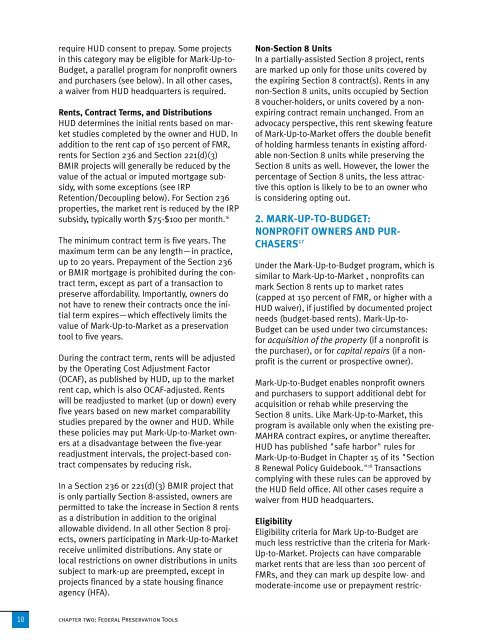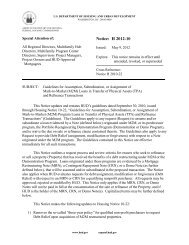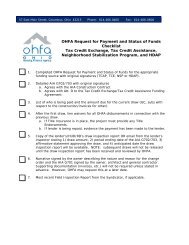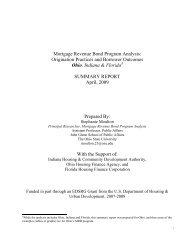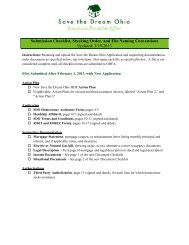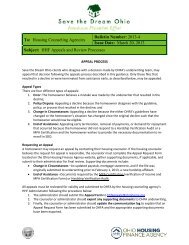lis 217 stemming the tide - LISC
lis 217 stemming the tide - LISC
lis 217 stemming the tide - LISC
- No tags were found...
Create successful ePaper yourself
Turn your PDF publications into a flip-book with our unique Google optimized e-Paper software.
equire HUD consent to prepay. Some projectsin this category may be eligible for Mark-Up-to-Budget, a parallel program for nonprofit ownersand purchasers (see below). In all o<strong>the</strong>r cases,a waiver from HUD headquarters is required.Rents, Contract Terms, and DistributionsHUD determines <strong>the</strong> initial rents based on marketstudies completed by <strong>the</strong> owner and HUD. Inaddition to <strong>the</strong> rent cap of 150 percent of FMR,rents for Section 236 and Section 221(d)(3)BMIR projects will generally be reduced by <strong>the</strong>value of <strong>the</strong> actual or imputed mortgage subsidy,with some exceptions (see IRPRetention/Decoupling below). For Section 236properties, <strong>the</strong> market rent is reduced by <strong>the</strong> IRPsubsidy, typically worth $75-$100 per month. 16The minimum contract term is five years. Themaximum term can be any length—in practice,up to 20 years. Prepayment of <strong>the</strong> Section 236or BMIR mortgage is prohibited during <strong>the</strong> contractterm, except as part of a transaction topreserve affordability. Importantly, owners donot have to renew <strong>the</strong>ir contracts once <strong>the</strong> initialterm expires—which effectively limits <strong>the</strong>value of Mark-Up-to-Market as a preservationtool to five years.During <strong>the</strong> contract term, rents will be adjustedby <strong>the</strong> Operating Cost Adjustment Factor(OCAF), as pub<strong>lis</strong>hed by HUD, up to <strong>the</strong> marketrent cap, which is also OCAF-adjusted. Rentswill be readjusted to market (up or down) everyfive years based on new market comparabilitystudies prepared by <strong>the</strong> owner and HUD. While<strong>the</strong>se policies may put Mark-Up-to-Market ownersat a disadvantage between <strong>the</strong> five-yearreadjustment intervals, <strong>the</strong> project-based contractcompensates by reducing risk.In a Section 236 or 221(d)(3) BMIR project thatis only partially Section 8-assisted, owners arepermitted to take <strong>the</strong> increase in Section 8 rentsas a distribution in addition to <strong>the</strong> originalallowable dividend. In all o<strong>the</strong>r Section 8 projects,owners participating in Mark-Up-to-Marketreceive unlimited distributions. Any state orlocal restrictions on owner distributions in unitssubject to mark-up are preempted, except inprojects financed by a state housing financeagency (HFA).Non-Section 8 UnitsIn a partially-assisted Section 8 project, rentsare marked up only for those units covered by<strong>the</strong> expiring Section 8 contract(s). Rents in anynon-Section 8 units, units occupied by Section8 voucher-holders, or units covered by a nonexpiringcontract remain unchanged. From anadvocacy perspective, this rent skewing featureof Mark-Up-to-Market offers <strong>the</strong> double benefitof holding harmless tenants in existing affordablenon-Section 8 units while preserving <strong>the</strong>Section 8 units as well. However, <strong>the</strong> lower <strong>the</strong>percentage of Section 8 units, <strong>the</strong> less attractivethis option is likely to be to an owner whois considering opting out.2. MARK-UP-TO-BUDGET:NONPROFIT OWNERS AND PUR-CHASERS 17Under <strong>the</strong> Mark-Up-to-Budget program, which issimilar to Mark-Up-to-Market , nonprofits canmark Section 8 rents up to market rates(capped at 150 percent of FMR, or higher with aHUD waiver), if justified by documented projectneeds (budget-based rents). Mark-Up-to-Budget can be used under two circumstances:for acquisition of <strong>the</strong> property (if a nonprofit is<strong>the</strong> purchaser), or for capital repairs (if a nonprofitis <strong>the</strong> current or prospective owner).Mark-Up-to-Budget enables nonprofit ownersand purchasers to support additional debt foracquisition or rehab while preserving <strong>the</strong>Section 8 units. Like Mark-Up-to-Market, thisprogram is available only when <strong>the</strong> existing pre-MAHRA contract expires, or anytime <strong>the</strong>reafter.HUD has pub<strong>lis</strong>hed "safe harbor" rules forMark-Up-to-Budget in Chapter 15 of its "Section8 Renewal Policy Guidebook." 18 Transactionscomplying with <strong>the</strong>se rules can be approved by<strong>the</strong> HUD field office. All o<strong>the</strong>r cases require awaiver from HUD headquarters.EligibilityEligibility criteria for Mark Up-to-Budget aremuch less restrictive than <strong>the</strong> criteria for Mark-Up-to-Market. Projects can have comparablemarket rents that are less than 100 percent ofFMRs, and <strong>the</strong>y can mark up despite low- andmoderate-income use or prepayment restric-10 chapter two: Federal Preservation Tools10


